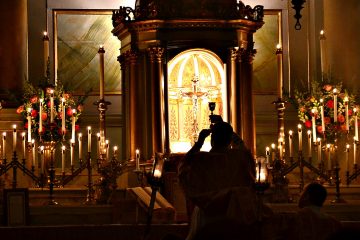Galveston-Houston readies for historic hurricane, first in 10-plus years

IMAGE: CNS photo/Darren Abate, EPA
By James Ramos
HOUSTON (CNS) — Hurricane Harvey’s pending landfall is bringing up memories of the last major storm that aimed for the Texas Gulf Coast.
Almost 12 years ago, Hurricane Rita churned through the Gulf of Mexico, aiming straight for the Texas coastline. While Houston escaped most major damage after landfall, the massive Category 3 storm brought weeks without electricity, winds more than 100 mph and mass evacuation headaches for the Greater Houston area, including Carla Martin.
“During Rita, evacuation was a nightmare on roadways,” Martin, office administrator at Mary Queen Catholic Church in Friendswood, told the Texas Catholic Herald, the Galveston-Houston archdiocesan newspaper. “(That experience) lends me to start preparations much earlier.” Mary Queen Catholic Church is located 33 miles from the Gulf of Mexico.
Like Martin, the Archdiocese of Galveston-Houston is preparing for Hurricane Harvey, as well as a number of other incidents that the Catholic community in Houston may face. Hurricane Harvey was expected to make landfall on the mid-Texas coast the night of Aug. 25, then stall and drift over the weekend of Aug. 26 and 27, according to the National Weather Service. By late afternoon Aug. 25, it was upgraded to Category 3.
The storm is estimated to bring 10 to 20 inches of rain to the Texas coastline, and winds up to 110 miles per hour. The National Hurricane Center said the historic storm will bring “catastrophic and life-threatening flooding” with “heavy rainfall of 15 to 25 inches, with isolated amounts as high as 35 inches, through Wednesday” and a “life-threatening storm surge” of 6 to 12 feet.
On Aug. 23, Texas Gov. Greg Abbott declared a state of disaster for 30 Texas counties, including Austin, Brazoria, Fort Bend, Galveston and Harris counties — each located in the archdiocese — due to the threat of imminent disaster posted by Hurricane Harvey. Grocery stores throughout the region were slammed with shoppers gathering last-minute basic supplies in anticipation of the worst.
Dozens of parochial schools and parishes closed early or suspended classes Aug. 25. The archdiocesan chancery offices also closed early that day in preparation for Hurricane Harvey.
Elsewhere in the state, the Diocese of Brownsville, in the southernmost tip, announced via Twitter that Catholic schools in the Rio Grande Valley were closed Aug. 25 in anticipation of the storm. It also published an emergency plan, in English and Spanish, for families in the path of the storm.
“Praying for the safety of everyone as storm makes landfall,” the diocese tweeted.
Bishop Daniel E. Flores of Brownsville said in a late afternoon interview Aug. 25 with Catholic News Service that the diocese took precautions, such as closing schools and other buildings, so people could prepare. Catholic organizations are communicating so they can respond to emergencies depending on what happens, but, at the moment, there are a lot of unknowns.
The biggest worry at the diocese, said Bishop Flores, are the populations in places called colonias, spontaneous subdivisions of makeshift homes on the outskirts of cities or towns, where the poor establish homes. Many are in low-lying areas, have weak infrastructure and the subdivisions may not have a sewer system, all which will become problematic should flooding and strong winds occur, he said.
“We have a plan to immediately coordinate our resources where they’re most needed,” after the storm, he said.
Catholic organizations, however, were on standby and planned to communicate with one another to help, he said. “We’re praying,” he said.
The Harris County Office of Homeland Security and Emergency Management was calling the storm a “dangerous flooding event for most of (Harris) county, if the forecast holds.” Houston Mayor Sylvester Turner posted on Twitter: “It never hurts to say a prayer for our city and for those in the path of the storm.”
To prepare for events like Harvey, parishes were invited to experience a hurricane scenario and explore their own policies and procedures step by step at workshops throughout the year.
Archdiocesan offices, including the Offices of Risk Management and Human Resources, as well as emergency officials from around the Greater Houston area, were on hand to provide resources and help parishes identify weaknesses and develop strengths of parish emergency plans. These meetings happen annually to help Catholic communities prepare for the unexpected.
Focusing on continuous improvement, Kirk Jenings, the director of Risk Management and Emergency Operations, said, “the key point of this exercise is that it is a great opportunity to learn about our (emergency operations) plan and develop our strengths in planning and communication.”
Hosted by Mary Queen Catholic Church in Friendswood, the workshop was facilitated by the Texas A&M Engineering Extension. Many parish staff, pastors and parishioners, from across the Archdiocese from parishes on Galveston Island and Bolivar Peninsula and Houston’s suburbs in every direction attend the regular trainings.
Delivered through a media presentation featuring a series of hurricane graphics provided by the National Weather Service, the scenario depicts the storm’s path, size and intensity. The presentation helped Martin gain a better understanding of her staff’s readiness for a hurricane and how to better prepare for the next one.
“The old plan did not start early enough in the process,” she said. “We must start earlier in the process, identifying needs to be done prior to evacuation.” Parishes in close proximity to the coastline, like Mary Queen, can be especially vulnerable to severe weather patterns.
The archdiocesan action plan for natural disasters encourages parishes and parishioners to actively prepare for any natural disaster.
“We encourage parishes with well-developed disaster committees and plans to share their knowledge with parishes that seek to improve their organization and plans,” Jenings said. “Our goals are two-fold. We desire to reach an optimal level of preparedness at both the parishes, schools and the chancery, and we want to resume normal operations as soon as possible following and event.
“Everyone in our local community, including our parishioners,” he continued, “needs to understand the potential impact a hurricane or other similar event will have upon the community and them as an individual.”
– – –
Ramos is a staff writer and designer for the Texas Catholic Herald, newspaper of the Archdiocese of Galveston-Houston. Rhina Guidos in Washington contributed to this story.
– – –
Copyright © 2017 Catholic News Service/U.S. Conference of Catholic Bishops. www.catholicnews.com. All rights reserved. Republishing or redistributing of CNS content, including by framing or similar means without prior permission, is prohibited. You may link to stories on our public site. This copy is for your personal, non-commercial use only. To request permission for republishing or redistributing of CNS content, please contact permissions at [email protected].













